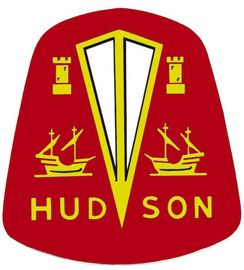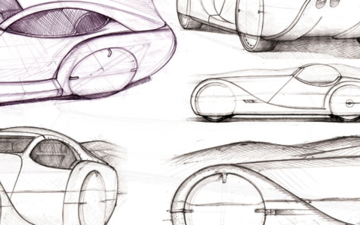Frank Spring
Designer
Frank Spring is best known for one of the most distinctive American cars of the '40s, the "step-down" Hudson, yet his career spanned more than 35 years, and he didn't begin life as a designer. Born into a wealthy West Coast family, he earned his mechanical engineering degree from the Paris Polytechnic in 1914, and after service with the U.S. Signal Corps, he became an engineer with the Courier Car Company of Sandusky, Ohio In the early 1920s he joined the Walter Murphy coach-building company in Pasadena as an efficiency manager, and in 1924, when Murphy's general manager George R. Fredericks drowned in an accident, Spring took over as general manager. William Murphy, uncle of coachbuilder Walter, was a friend of the Lelands, which led to the younger Murphy taking the Lincoln agency for California. In December 1926 they changed the agency to Hudson-Essex. Possibly Spring had links with Hudson already, though this has not been proven. Certainly Murphy built bodies on Hudson chassis, and in 1931 Spring moved to Hudson. Like Harley Earl, Spring was not a hands-on designer. Strother McMinn, who worked for him at Hudson, says that he made assignments and supervised the design activity, but never put pencil to paper. Frank Hershey says that he might specify or indicate a preference, but never invented a design. He was more interested in gadgets and ingenious constructions than in the overall lines of the body. In his time at Murphy, he adapted a design by the Swiss coachbuilder Gangloff in which the front and rear doors were hinged at the B-pillar, allowing the glass drop frames to be very close together. This made for a light and airy interior with maximum visibility. Spring improved on the Gangloff design by substituting an aluminum forging for Gangloff's light fabrication. This forging extended to the floor level and helped to eliminate side distortion of the body, even when the top was removed, as on a convertible sedan. Murphy called such cars "Clear Vision" models and used the design in sedans, convertible sedans, and town cars.
In September 1931 it was announced in the automotive press that Frank Spring had been appointed style engineer at Hudson, though he had, in fact, been working there for several months. Like all other car makers, Hudson did not have a styling department up to that date. As Don Butler said in his History of Hudson, "Before styling began to emerge as a necessary factor, stylists were rare, and body engineers applied whatever untrained styling touches they could muster."
Subject ID: 77442
MoreFrank Spring is best known for one of the most distinctive American cars of the '40s, the "step-down" Hudson, yet his career spanned more than 35 years, and he didn't begin life as a designer. Born into a wealthy West Coast family, he earned his mechanical engineering degree from the Paris Polytechnic in 1914, and after service with the U.S. Signal Corps, he became an engineer with the Courier Car Company of Sandusky, Ohio In the early 1920s he joined the Walter Murphy coach-building company in Pasadena as an efficiency manager, and in 1924, when Murphy's general manager George R. Fredericks drowned in an accident, Spring took over as general manager. William Murphy, uncle of coachbuilder Walter, was a friend of the Lelands, which led to the younger Murphy taking the Lincoln agency for California. In December 1926 they changed the agency to Hudson-Essex. Possibly Spring had links with Hudson already, though this has not been proven. Certainly Murphy built bodies on Hudson chassis, and in 1931 Spring moved to Hudson. Like Harley Earl, Spring was not a hands-on designer. Strother McMinn, who worked for him at Hudson, says that he made assignments and supervised the design activity, but never put pencil to paper. Frank Hershey says that he might specify or indicate a preference, but never invented a design. He was more interested in gadgets and ingenious constructions than in the overall lines of the body. In his time at Murphy, he adapted a design by the Swiss coachbuilder Gangloff in which the front and rear doors were hinged at the B-pillar, allowing the glass drop frames to be very close together. This made for a light and airy interior with maximum visibility. Spring improved on the Gangloff design by substituting an aluminum forging for Gangloff's light fabrication. This forging extended to the floor level and helped to eliminate side distortion of the body, even when the top was removed, as on a convertible sedan. Murphy called such cars "Clear Vision" models and used the design in sedans, convertible sedans, and town cars.
In September 1931 it was announced in the automotive press that Frank Spring had been appointed style engineer at Hudson, though he had, in fact, been working there for several months. Like all other car makers, Hudson did not have a styling department up to that date. As Don Butler said in his History of Hudson, "Before styling began to emerge as a necessary factor, stylists were rare, and body engineers applied whatever untrained styling touches they could muster."
Hudsons were never style leaders in the 1930s, but the company kept up with current trends such as fender skirts (from 1933), while the fencer's mask grilles on the 1936 models were certainly eye- catching. The sports-car-loving Frank Spring would doubtless have liked a lower body line, but Hudson was run by a hat-wearing conservative, Edward Barit who, like Kaufman Keller at Chrysler, insisted on a high roof line. It is all the more remarkable that Barit eventually succumbed to the charms of Frank Spring's most revolutionary car, the so-called "step-down" Hudson, which was launched in October 1947.
Subject ID: 77442
Subject ID: 77442

